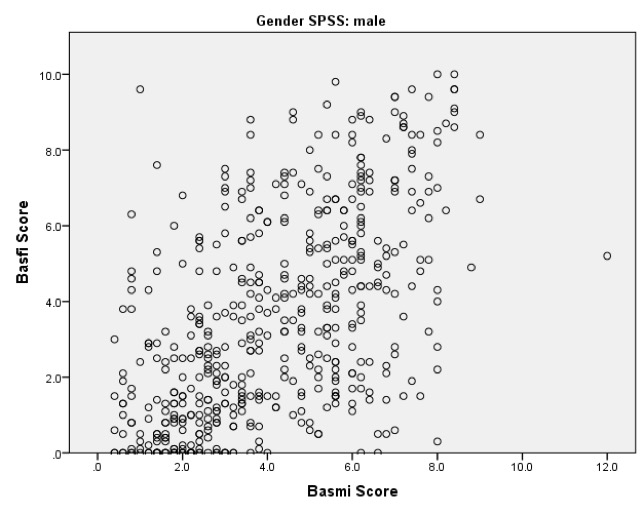Session Information
Date: Monday, November 9, 2020
Session Type: Poster Session D
Session Time: 9:00AM-11:00AM
Background/Purpose: Axial spondyloarthropathy (axSpA) is a form of inflammatory arthritis affecting the axial skeleton. Persistent disease activity can result in restricted spinal mobility over time, and is presumed to lead to functional impairment although evidence to date on this subject has been limited. The Ankylosing Spondylitis Registry of Ireland (ASRI) is a source of epidemiological data on patients with axSpA in Ireland. The aim of this study was to examine the relationship between degree of spinal mobility (as assessed by BASMI score) and effect on functional ability (as assessed by BASFI score).
Methods: IBM SPSS version 24 was used to run the analysis of the patient population registered in the ASRI to date. Patients with both BASFI and BASMI scores were included in the analysis. Both variables were assessed with a Shapiro-Wilk’s test for normal distribution. Variables were also assessed for presence of a monotonic relationship by visual inspection of a scatterplot of the two variables. Once a monotonic relationship was established a Spearman’s rank-order correlation between BASMI and BASFI was analyzed. Further analysis with a Pearson’s partial correlation was preformed to control for gender. Records were then split by gender and a Spearman’s rank-order correlation was undertaken to assess strength of correlation of scores within each gender.
Results: In total 847 patients were assessed for inclusion. Data on both BASMI and BASMI scores were available on 647 of these patients, which were included in the analysis. Variables were not normally distributed as assessed by Shapiro-Wilk’s test (p< 0.01). Preliminary analysis showed the relationship between these measures to be monotonic (as the BASFI score increases, so too does the BASMI score), as determined by visual inspection of the scatterplot. There was a statistically significant, strong positive correlation between BASMI and BASFI scores in axSpA patients, rs(645) =0.509, p=0.001(figure 1) based on calculations by Spearman’s rank-order correlation. A Pearson’s partial correlation showed that the strength of this correlation was stronger when controlled for gender, rpartial(645) =0.521, and remained statistically significant p< 0.001. A Spearman’s rank-order correlation analysis following splitting of records by gender showed the correlation becomes stronger if assessed within each gender (Females rs(144)= 0.577, p< 0.01; Males rs(509) =0.576, p< 0.01) and has a slightly stronger association with in females(figure 2).
Conclusion: BASFI scores have a strong positive correlation with BASMI scores in patients with axSpA. In clinical terms, patients with worse limitation of spinal mobility are likely to have greater level of functional impairment and vice versa. Analysis by gender shows this correlation is more significant if compared within each gender, and is slightly stronger in females with axSpA.
 Figure 1: Correlation between BASFI and BASMI in the ASRI population
Figure 1: Correlation between BASFI and BASMI in the ASRI population
 Figure 2a: Correlation between BASMI and BASFI in Males
Figure 2a: Correlation between BASMI and BASFI in Males
 Figure 2b: Correlation between BASMI and BASFI in Females
Figure 2b: Correlation between BASMI and BASFI in Females
To cite this abstract in AMA style:
Maguire S, Gallagher P, O'Shea F. Spinal Mobility and Function: How Closely Do They Associate in Axial Spondyloarthropathy? [abstract]. Arthritis Rheumatol. 2020; 72 (suppl 10). https://acrabstracts.org/abstract/spinal-mobility-and-function-how-closely-do-they-associate-in-axial-spondyloarthropathy/. Accessed .« Back to ACR Convergence 2020
ACR Meeting Abstracts - https://acrabstracts.org/abstract/spinal-mobility-and-function-how-closely-do-they-associate-in-axial-spondyloarthropathy/
